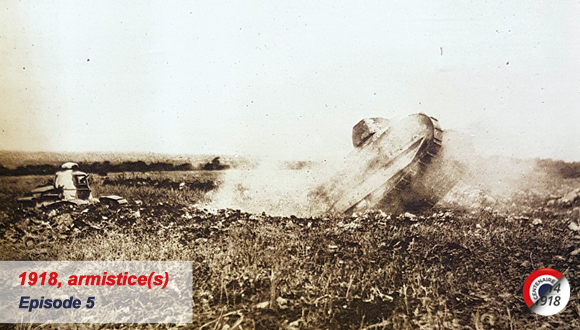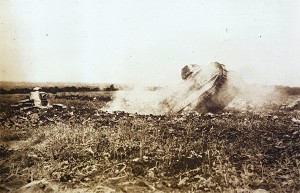The American artillery and cavalry contributed to the success of the operations helped dismantle the Saint-Mihiel salient. These photographs from Le Miroir show: 1- a tank in action; 2- tanks coming in to replenish their ammunition stores. © Paris, musée de l’Armée.
Le Miroir published this photo on 29 April 1917 with the caption: The US army already has formidable ‘tanks’. They offered the Allies to send them ‘Tanks’. The proposal could become reality within a short time. Pictured is indeed the classic image of the American war machine that has just proved its worth on the ground, with excellent results. In two places, the Caterpillar brand can be seen. The term “caterpillar” is used instead of the term “tank” (which in turn as the code name used by the British, and was understood in French as being equivalent to the fuel reservoir) to designate the Renault FT tanks used by the Americans. © Paris, musée de l’Armée
French and American soldiers are propped up on a Renault FT tank. This poster seems an illustration of Pétain’s words: “I’m waiting for tanks and the Americans.” An allegory of victory stands on the turret of the tank. It brandishes a crown of laurel, a symbol of victory and glory. A Renault FT tank is on display in the south-west corner of the courtyard. © Paris, musée de l’Armée, dist. RMN-GP / Pascal Segrette
1918, on the Western Front
The peace negotiations in Brest-Litovsk (December 1917 to March 1918), with the Russians and those in Bucharest with the Romanians, accentuated the disagreements between the Central Powers on the issue of territories and borders. Germany isolated itself by not taking sufficient account of the demands and interests of its allies. It also had to face deep-set disagreements between German politicians and military.
This shift in the conflict caused great concern among the Allies, as some of the German troops on the Eastern fronts were being transferred to back up those on the Western Front. Meanwhile, since the entry of the United States into the war (April 1918) alongside the Allies, the General in Chief of the Reich Army, Erich Ludendorff, wanted to speed up the peace negotiations, new American troops strengthening the Entente camp a little more each month. Like the British and the French, it had to deal with the problem of the renewal of reserve troops, while those being used were tired and suffering losses.
Major offensives
In March 1918, Ludendorff and Paul von Hindenburg, the head of the Imperial Army’s Grand Staff, wanted to strike a decisive blow on the Western Front and launched major offensives. As stark divergences were emerging between the Allies, the two governments decided to entrust the command of the Franco-English army to a single leader. General Foch was thus charged with coordinating the action of the Allied armies on the Western Front. Despite the progress of the Germans, Foch applied his plan: to cover the capital without abandoning Amiens. On March 28, US General John Joseph Pershing made his army available to the new leader. The first American divisions were sent to battle in June. The power of the war industries was at this point another factor in favour of the Allies and their American associates.
In July 1918, a new German offensive was launched in Champagne, but it was quickly headed off, the Allies having been informed of the operation. Foch was organising a counter-attack in the Villers-Coterêt forest sector, with regiments, artillery pieces and tanks. The Germans were losing ground and some believed that peace talks should be initiated, while Ludendorff wanted to resume the offensive in order to negotiate for the benefit of the Reich.





Ajouter un commentaire